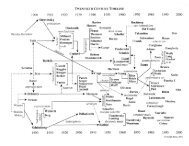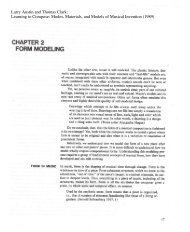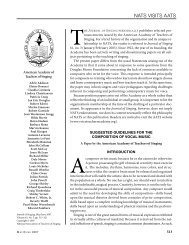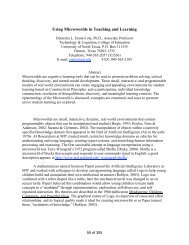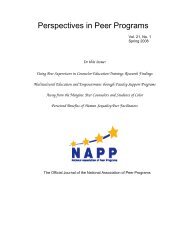Composing with Pitch-Class Sets - UNT
Composing with Pitch-Class Sets - UNT
Composing with Pitch-Class Sets - UNT
Create successful ePaper yourself
Turn your PDF publications into a flip-book with our unique Google optimized e-Paper software.
<strong>Composing</strong> <strong>with</strong> <strong>Pitch</strong>-<strong>Class</strong> <strong>Sets</strong>
Using <strong>Pitch</strong>-<strong>Class</strong> <strong>Sets</strong> as a Compositional Tool<br />
0 1 2 3 4 5 6 7 8 9 10 11<br />
<strong>Pitch</strong>es are labeled <strong>with</strong> numbers, which are enharmonically equivalent (e.g., pc 6 = G flat,<br />
F sharp, A double-flat, or E double-sharp), thus allowing for tonal neutrality.<br />
Reducing pitches to number sets allows you to explore pitch relationships not readily<br />
apparent through musical notation or even by ear: i.e., similarities to other sets, intervallic<br />
content, internal symmetries.<br />
The ability to generate an entire work from specific pc sets increases the potential for<br />
creating an organically unified composition.<br />
Because specific pitch orderings, transpositions, and permutations are not dictated as in<br />
dodecaphonic music, this technique is not as rigid or restrictive as serialism.<br />
As <strong>with</strong> integral serialism, pc numbers may be easily applied to other musical parameters:<br />
e.g., rhythms, dynamics, phrase structure, sectional divisions.
Two Representations of the Matrix for Schönberg’s Variations for Orchestra<br />
a. Traditional method, using pitch names b. Using pitch class nomenclature<br />
(T=10, E=11)
Terminology<br />
pitch class — a particular pitch, identified by a name or number (e.g., D = pc 2)<br />
regardless of registral placement (octave equivalence).<br />
interval class (ic) — the distance between two pitches expressed numerically,<br />
<strong>with</strong>out regard for spelling, octave compounding, or inversion (e.g., interval class<br />
3 = minor third or major sixth).<br />
pitch-class set — collection of pitches expressed numerically, <strong>with</strong>out regard<br />
for order or pitch duplication; e.g., “dominant 7th” chord = [0,4,7,10].<br />
operations — permutations of the pc set:<br />
• transposition: [0,4,7,10] — [1,5,8,11] — [2,6,9,0] — etc.<br />
• retrograde: [0,4,7,10] — [10,7,4,0]<br />
• Inversion: [0,4,7,10] inverts to [0,8,5,2] — name that chord…?<br />
• rotation: [0,4,7,10] — [4,7,10,0] — [7,10,0,4] —[10,0,4,7]<br />
normal order — the arrangement of a pc set in ascending order and in the<br />
most intervallically compact form: rotate [0,4,7,10] to [4,7,10,0]; then invert to<br />
[4,6,9,0] to determine best normal order (<strong>with</strong> the smallest intervals to the left).<br />
prime form — the transposition of the best normal form of the pc set<br />
beginning on 0: transpose [4,6,9,0] to [0,2,5,8] to get the prime form.
Terminology<br />
invariance — sets that contain duplications under the operations of<br />
transposition and/or inversion (I.e., symmetrical pc sets).<br />
subsets and supersets — smaller pc sets contained <strong>with</strong>in a larger set (subset)<br />
or larger sets that include smaller sets (superset): e.g., [0,2,5] of a subset of<br />
[0,2,5,8], while [0,1,2,5,7,8] is a superset that contains [0,2,5,8].<br />
complementary set — the set of pitch classes not present <strong>with</strong>in any given pc<br />
set: e.g., the complement of [0,2,5,8] is [1,3,4,6,7,9,10,11] (prime form =<br />
[0,1,2,4,5,7,8,10]).<br />
interval vector — the array of possible intervals available <strong>with</strong>in each pc set.<br />
Z relation — two pc sets that have the same interval vector.<br />
K-relation and Kh-relation sets — when a pc set occurs as a subset/superset<br />
of another pc set and/or its complement.<br />
Forte set-class names — Allen Forte in The Structure of Atonal Music (1973)<br />
organized all 3- to 9-note sets (expressed in prime form) and labeled them by<br />
cardinality (trichord, tertrachords, etc.); e.g., pc set [0,2,5,8] is labeled as pc set<br />
4-27. Each pc set listing also includes the interval vector and complementary<br />
set, as well as any inversional invariance (indicated parenthetically) or Z relation.
Prime Forms and Vectors of <strong>Pitch</strong> <strong>Class</strong> <strong>Sets</strong> (Allen Forte)
Prime Forms and Vectors of <strong>Pitch</strong> <strong>Class</strong> <strong>Sets</strong> (Allen Forte)
Prime Forms and Vectors of <strong>Pitch</strong> <strong>Class</strong> <strong>Sets</strong> (Allen Forte)
Deriving <strong>Pitch</strong>-class <strong>Sets</strong>—Clock Method<br />
C<br />
P4<br />
M3<br />
TT<br />
m2<br />
B b<br />
B<br />
7<br />
C #<br />
D<br />
M2<br />
P4<br />
M2<br />
m3<br />
M3<br />
M2<br />
A<br />
5<br />
E b<br />
Plot the pitches on a clock graph<br />
Determine the largest space between<br />
adjacent points; of these two points, find<br />
the smallest adjacent interval in the<br />
opposite direction.<br />
<strong>Pitch</strong>es will be labeled in the direction<br />
of this small interval; begin labeling <strong>with</strong><br />
zero [0] and count upwards from there.<br />
Identify pitch class set on Forte chart.<br />
A b<br />
G<br />
0<br />
smallest interval<br />
1<br />
F #<br />
[0,1,3,5,7] = pc set 5-24<br />
m2 M2 m3 M3 P4 TT<br />
interval vector = 1 3 1 2 2 1<br />
3<br />
F<br />
E<br />
WEBSITE
Igor Stravinsky (left) and Elliott Carter in 1961.
Application of <strong>Pitch</strong> <strong>Class</strong> <strong>Sets</strong> in Igor Stravinsky’s<br />
Three Songs from William Shakespeare, No. 1 (1953)<br />
<strong>Pitch</strong>-class set 4-2 [0, 1, 2, 4]<br />
R<br />
1 2 4<br />
RI<br />
1 2 4<br />
RI<br />
1 2 4<br />
R<br />
1 2 4<br />
4 2 1<br />
P<br />
4 2 1<br />
I<br />
4 2 1<br />
P<br />
4 2 1<br />
I<br />
4 2 1<br />
P<br />
4 2 1<br />
I<br />
etc.<br />
P<br />
• Chain of interval classes [1], [2], and [4]<br />
• Inversional symmetry between segments<br />
I
<strong>Pitch</strong> <strong>Class</strong> Set Analysis of Alban Berg’s Wozzeck (Act II)



